-
Posts
641 -
Joined
-
Last visited
Content Type
Profiles
Forums
Gallery
Events
Posts posted by schooner
-
-
Done at last!
I'll post some pix in the "completed kit models" section soon.
In case you are wondering (no pun intended) the all - acrylic case in the last pix was custom made by Abordage.com in remarkably short time. If you decide to use them make sure you specify the thickness of the plexi you want (I used 1/8 inch) they also provide base boards although I made my own.
- Altduck, Captain Slog, rvchima and 9 others
-
 12
12
-
Thanks Greg and Scott!
Scott, just in case you didn't know - BlueJacket has the same ship in the WWII 6-gun version in case you dad was a mid on the Glennon before her FRAM update. Either way I highly recommend the kit - all the hard work is done for you, the engineering is great and the scale is not an eyestrain but it is not nearly as big as some 3-master build
Tim
-
Final deck details
The last major item to add was the lifelines around the main deck. I wanted to add webbing between the deck and the lower 2 lifelines, like you can see in the background of this photo:
I thought it would be a simple job to add some black Florist’s mesh but it was slow and tedious to glue it on, trim it, re-glue those areas that pulled away while trimming, retouch up the paint, reglue the mesh where it pulled away during the paint touch up, etc, etc etc. It ended up taking about 5 or 6 hours to get them all done. Believe it or not they actually sell PE for use with 1/350 scale kits. Here is one completed section:
I glued it to the model using CA glue and a really neat applicator recommended by my hobby shop which had just got them in. They come in several sizes of loops, are made of steel PE and fit in the end of a X-Acto knife handle. They work great for getting CA just where you want it and it cleans up just by holding it over a match flame (I had no idea how flammable CA is (even when dry), I’ll start being very conscious of where my glue bottles are in relation to heat or flame)
The railings went on easily. Diagonal braces were added at various spots.
The boat boom and scramble net in this pix are scratch additions:
The red and green things in this pix are simulated anchor bouys which used to be jury-rigged out of empty 5” powder casing containers with light line looped around them. The jackstaff is also included in the stowed position on deck:
Only about one hour’s work left to add the props, rudders and the prop guards and then this cake is baked.
- s4usea, WackoWolf, steamschooner and 4 others
-
 7
7
-
-
-
Thanks for the encouragement Chris.
It's been a fun build because the kit itself is so good that I didn't need to spend anytime fixing it, I could just get carried away with detailing it, although I still think about things that I wish I could add but just can't figure out how to. Picking a type of ship with plenty of photo references was an unplanned but BIG help.
- WackoWolf, mtaylor and justsayrow
-
 3
3
-
- Captain Slog, WackoWolf, joske and 6 others
-
 9
9
-
-
Rigging
While getting ready to rig the forward 3-wire HF fan antennas I did some photo research and figured out that the antenna wires were so thin that they barely showed up even on close-up photos of the FRAMS. Finding some thin thread was no problem but for the sake of accuracy and consistency I had to re-do the aft fan antennas.
Here’s the re-do in progress, the original, thicker ones are to port and the thinner revised ones to starboard:
The forward mast rigging included the signal halyards which were helped by some small 1/350 scale PE hardware I bought from L’Arsenal, the flag halyard, and 3-wire fans forward and starboard aft:
Next up will be the HF whip antennas.
- ScottRC, justsayrow, Nirvana and 4 others
-
 7
7
-
-
Hi Paul,
Amazing PE work!!!
Mind if I ask you a technique question re painting? After I finish my current 1/192 DD build I'm going to try my hand using an airbrush for the first time on a 1/350 resin kit. My question has to do with painting decks vs bulkheads and when to put on the PE.
Taking your superstructure area just forward of the forward funnel as an example: you have several areas where you have PE railings around the deck edges. Do you plan to paint the deck a darker color than the vertical surfaces? If so will you airbrush everything haze grey and then go back an brush paint the decks or will you paint the decks first, mask them, and then spray the vertical surfaces?
Sorry if these seem like dumb questions but I have seen a lot of builds (including "how-to" books) where an unpainted model has a ton of PE on it and the next photo in the sequence shows everything painted, including a different paint color on the decks yet it is never explained how it all happened.
thanks for any help.
-
Foc’sle details
The kit provides brass chain for the anchor chain. Looking at it I thought it might be a bit under scale but after looking at photos of the Basilone’s anchor chain I realized that it was actually just a little bit over scale.
I was surprised to see how small the anchor links were on the FRAMs. On the Frigates and DDs I served on, although the ships were about 1/3 larger than the FRAMs, their chain links were at least 3 times as large, big enough that you needed some beef on you just to lift one. As you can see in the photo below the FRAM links were only about 6-8” in length, about the span of you thumb to little finger. But after checking my 1952 edition of Knight's Modern Seamanship I learned that anchor chain size (i.e. strength) is based on the sail area of the ship and the force the wind it will generate on an anchored ship. My ships had a lot more sail area and hence needed bigger chain.
I fabricated some chain stoppers out of brass wire and managed to get them into a reasonable working facsimile with a hinged bail:
The only other details are the towing pad eye and the capstan and it’s controls:
The “guyed” whip antenna on top of MT 51 was made out of steel piano wire, cooper wire, wood, thread, and white glue. It took several iterations and some un-Christmas like language to finish it up. I've noticed that my cheap camera and poor photography skills tend to produce a fisheye effect on close-up photos that make things (like this antenna) appear to be tilted, not sure how to correct or avoid it, guess I may have to get a better camera...
Next up will be rigging the mast.
-
- Captain Slog, s4usea, Nirvana and 6 others
-
 9
9
-
Mark,
It is definitely a 55 gal drum. I'm 99% sure it contained gasoline for use in the portable firefighting and dewatering pumps. Gasoline aboard ship is liquid death and the USN avoids it whenever possible and always stores it on the weather decks.
The photo was provided to me by a Basilone sailor who was able to identify several of the folks in it, kind of brought it to life a little.
As far as the "khakis" not wearing life jackets it is the old story of "do as I say not as I do" - some things never change.
-
Thanks for the kind words Per. Scratching details on a modern ship is easy since there are so many photos online.
Your America is coming along beautifully, very crisp and sharp . Not many models, mine included, can handle the pitiless eye of high resolution photos but yours' certainly does.
-
Fantail Details
Basilone’s fantail was pretty cluttered with winches, hatches, vents etc ….
I scratched most of the details like the boat winch:
The bits, bollards, and horizontal hatch are kit supplied. The stern light array, winches and their bulwarks, vents, towing pad eye and the 55 gal drum and jettison rack are from scratch.
The only items left to add to the fantail are the lifelines and the prop guards. One item I decided to leave off is visible just to the left of the 55 gal drum in the first pix - a large and ugly garbage chute.
- GuntherMT, ccoyle, Old Collingwood and 5 others
-
 8
8
-
Whaleboat Davits (cont)
Home repairs, travel and trout trout fishing have proved a big distraction so it’s time to try to catch up.
I wanted to show the MWB with the “Monkey Line” bags which held knotted lines that the boat crew would hold onto during the raising and lowering of the boat in case of a sudden drop. They often spelled out the ship’s name or hull number. Here’s what they looked like:
I printed them out on paper, folded them and glued the back and front together with the top open and shaped with a toothpick to hold them open.
Here’s the final product with the davit vangs rigged:
-
I really enjoyed Model Shipways Chesapeake Skipjack "Willie L. Bennett". You build the model the same way the original boats were, the plans allow for all the interior detailing, deck beams, etc. The only deviation from the real thing is the use of ply sheet for the side planks although the plans show the planks and it would be easy to make your own. The plan sheet is very detailed and the instruction book is the best I have seen - it even includes drawings of the complicated steering gear if you have the skills and desire to scratch your own. When you are done with the kit you will have a Masters in Skipjack construction.
-
Hi Ben,
This looks like it will be a great build.
Do you happen to know if the E.F. was built on traditional ways or in dry dock and then floated out? I'm curious because she seems pretty big to handle the dynamic stresses of launching on ways. Just wondering.
As far as the resin flaws go I have done a few small kits and have found that resin is much like wood in that you can glue a piece of poly into the gap and then carve and sand it to shape. Looks like scratching a new pilot house is doable. If you find the hull is warped I recommend you check out some of the plastic ship modeling sites like Steelnavy and ModelWarships, folks on their forums can give you some great tips on how to straighten it out (it's a fairly common problem)
Good luck with the build!
Tim
-
Fan Antennas
With a lot of home renovations going on lately it has been tough to find some modeling time - hopefully the hurricane will keep me indoors and at loose ends long enough to get some more done.
The Gearings had several sets of 3-wire HF fan antennas. I decided to do the ones between the aft stack and ECM tower now so I didn’t whack something trying to reach that area later.
The wires are made from thin flyfishing leader material. It took a long time to track down something to use for the insulators. I tried some glass beads (shown on left below) but they were over scale. I then though of using insulated wire whose insulation material I could slide over the “wire” to simulate the insulators but after striking out at several electrical supply shops I found some online. It was cheap but the necessary wire stripper was not. After stripping off a length of insulation I cut it to length. The piece in the middle below was OK but going down one more size in wire gage diet the trick:
The “fish plates” where the wires join is just a piece of strip plastic with small holes drilled in it. The connecting wires (not sure of the technical name) is just a strand of the copper wire whose insulation I had used. Pix of the antennas before and after painting:
- GuntherMT, Ray, Captain Slog and 4 others
-
 7
7
-
-
Whaleboat Davits
After a too long break for vacation, home repairs, and trying to tease out a final few trout before the heat sets in its about time to get back to the model.
The MWB has been set in place, keel rests scratched and the davits rigged. The “falls” between the blocks are just painted fly line since it would have been beyond my patience and skills to try to fit working double blocks in such a small space.
Next will be an attempt to rig monkey lines above the boat and rig the guy wires on the radial davit arms.
- Leo-zd, ccoyle, Captain Slog and 5 others
-
 8
8
-
Flight Deck Nets
The kit provides some nice PE safety nets for the sides of the flight deck (they were not added to the aft part of the flight deck until several years after the time I am depicting). The instructions call for installing them in the raised (vertical) position but since I will show the DASH on the deck I chose to mount them in the lowered (horizontal) position, which would require some modifications. Since PE is inherently thin if viewed side-on the PE would appear under-scale for thickness. I decided to line the PE nets with brass wire to give them more depth:
But after making the wire frame I thought I might try adding my own netting using some fine plastic netting from the craft store (I think it is intended for floral arrangements). As you can see from the attached photo the netting should be very fine, almost invisible.
Here’s my first attempt after spray painting (2nd from the top below) - not too good, the paint made a mess of the netting. Next I tried adding the netting after spray painting the frames (the 3rd from the top in the photo below), better but the frames still looked bad so I threw out the spray paint, painted the frames by hand and then added the netting (bottom one in the below photo) - much better. The craft store mesh is to scale and as an added bonus the openings are diamond-shaped, just like the real things!
After making and installing the nets I wanted to add the “guy wires” (for lack of a better term) that support the nets in the lowered position. I decided to drill a hole in some small strip plastic and insert a piece of 3X fly fishing leader material, cut off the small piece of strip stock, paint it and install it. Here it is being assembled and after installation prior to trimming:
Here’s the finished product:
Next step will be the whaleboat and davits.
- justsayrow, mtaylor, capnharv2 and 8 others
-
 11
11
-



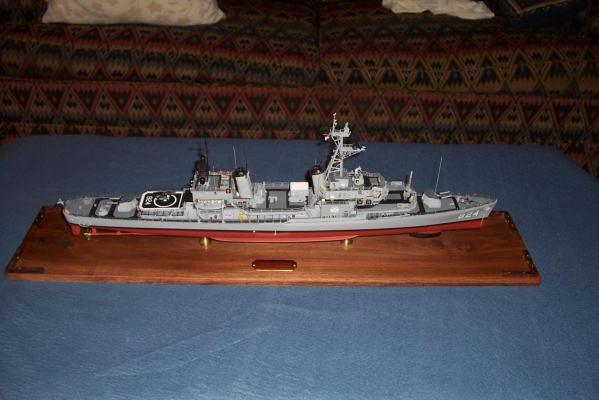
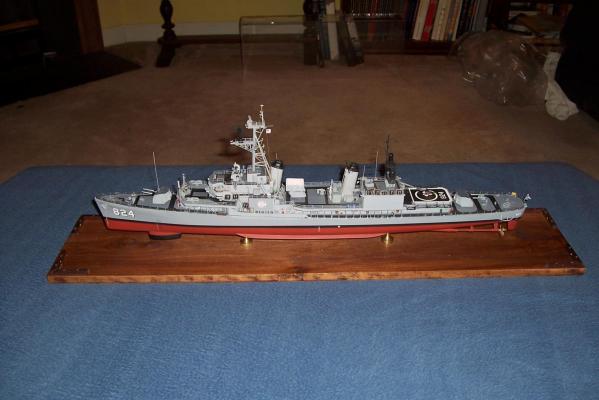
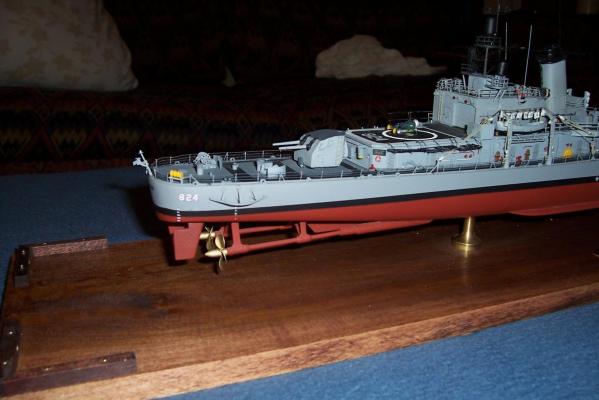

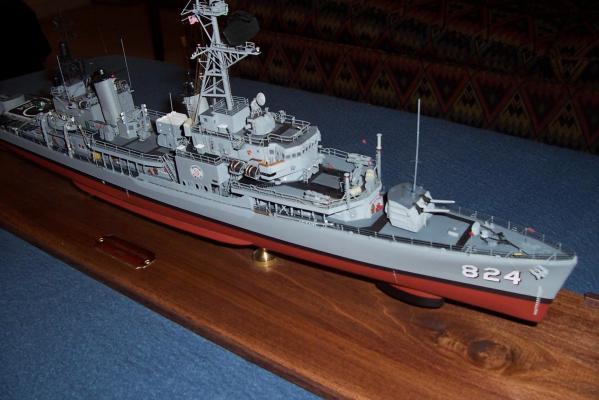
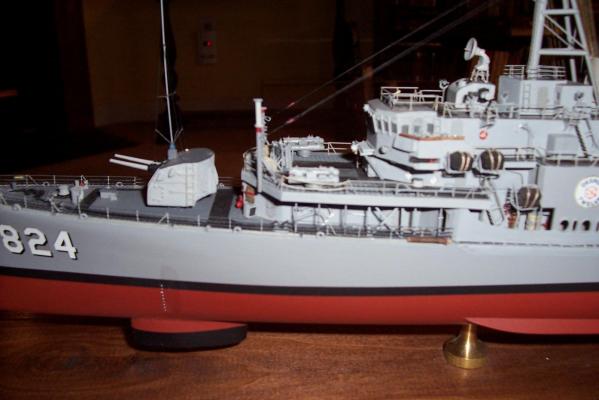
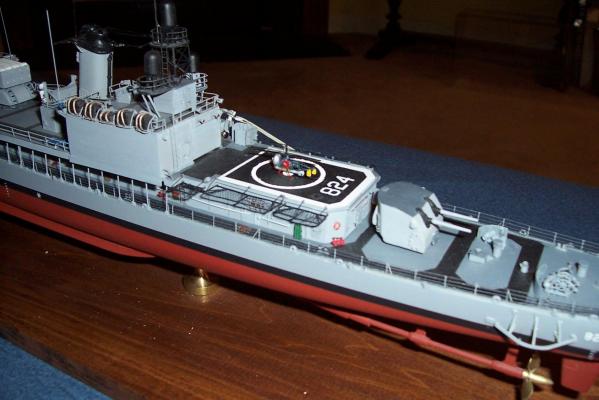
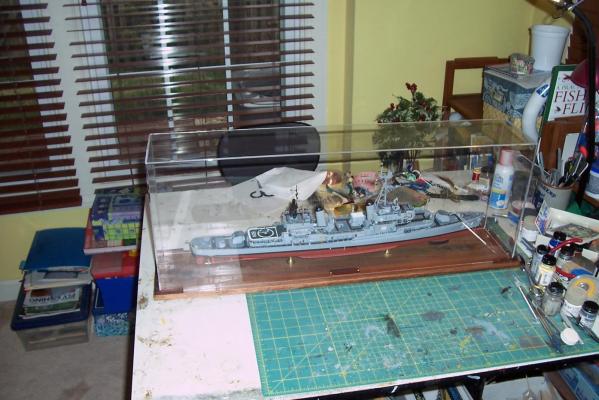

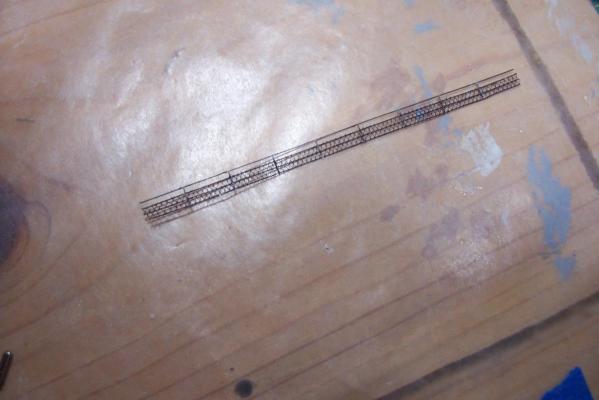
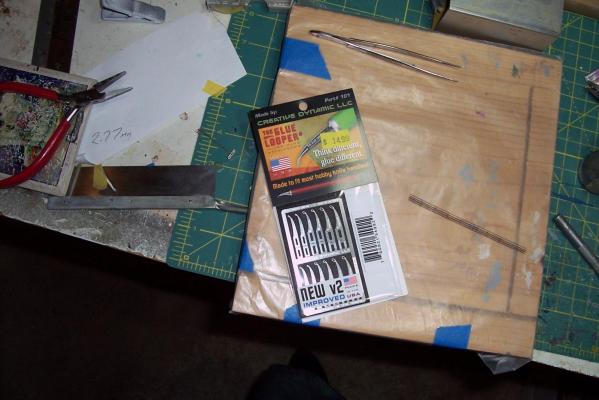
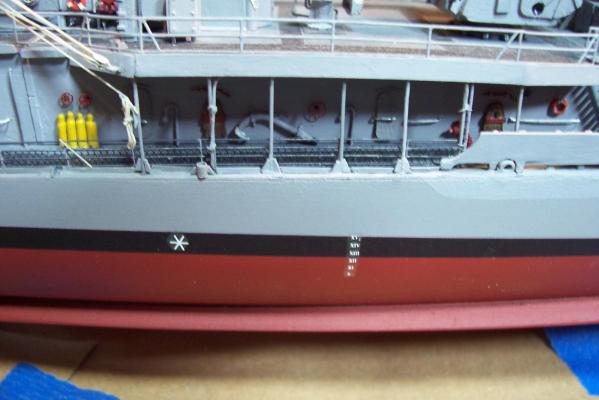
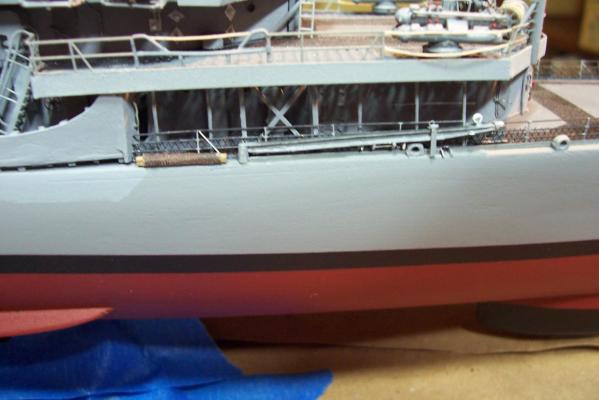
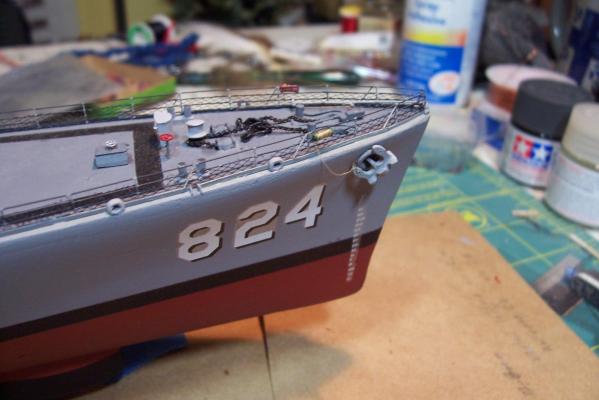
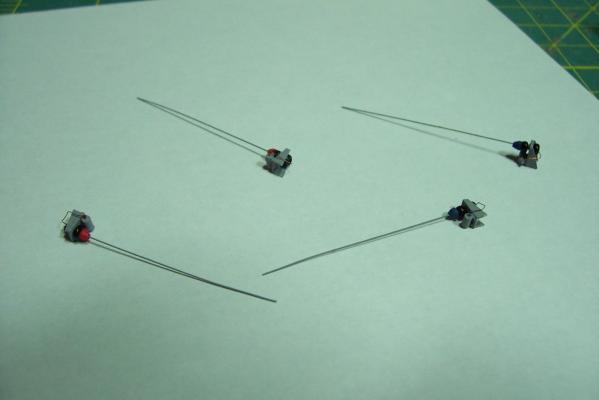
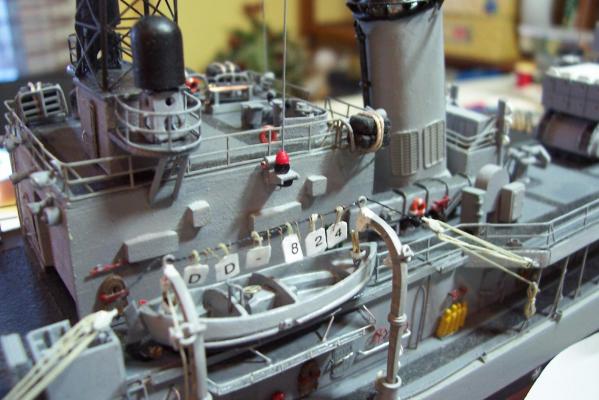
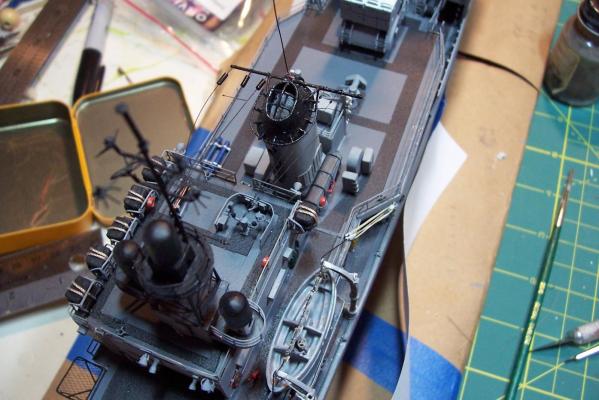
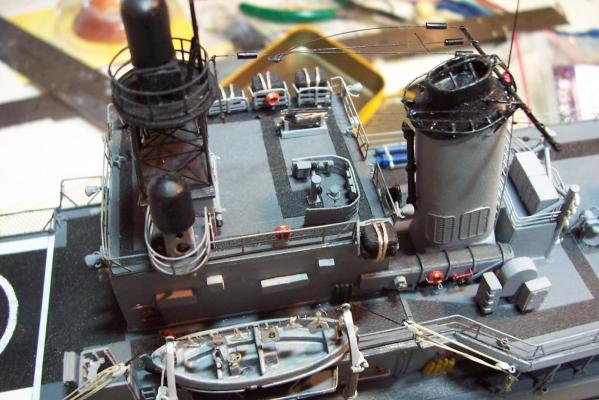
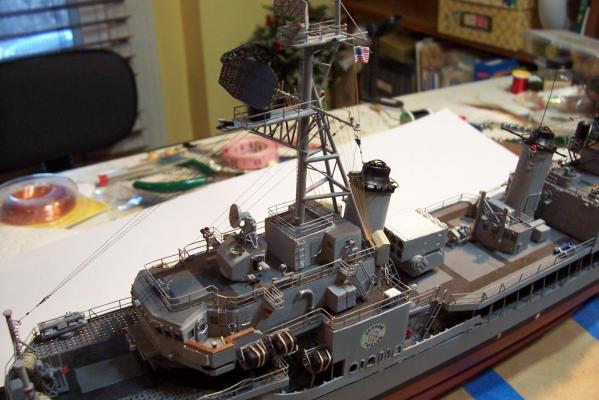
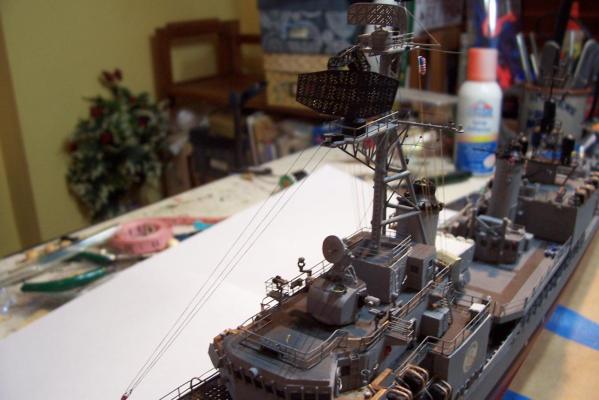
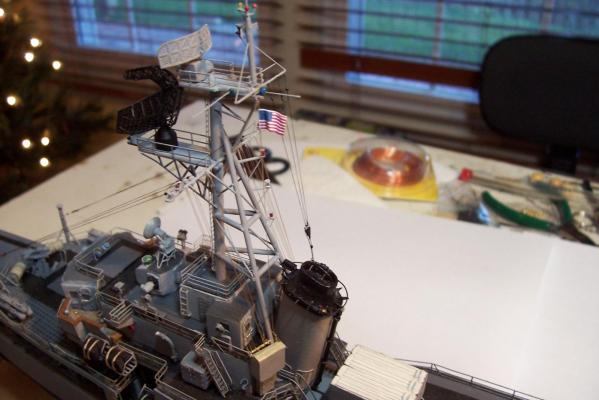
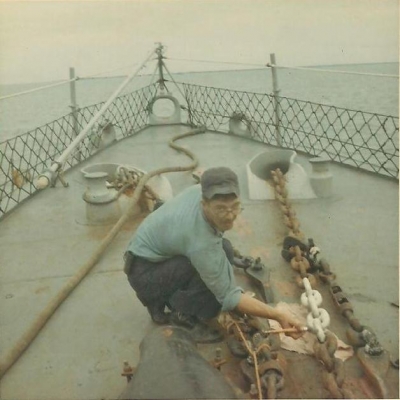
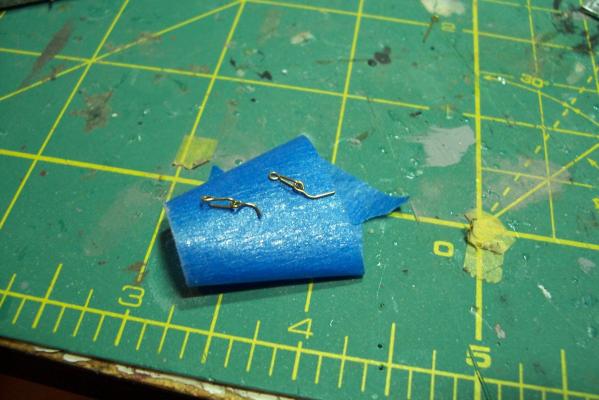
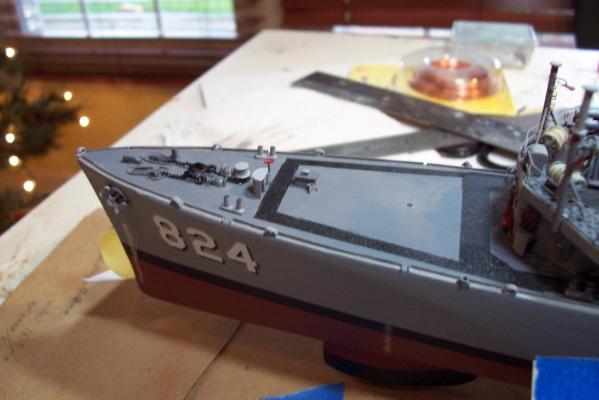
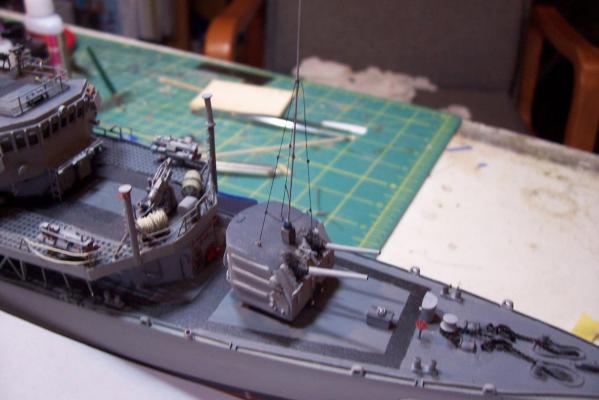
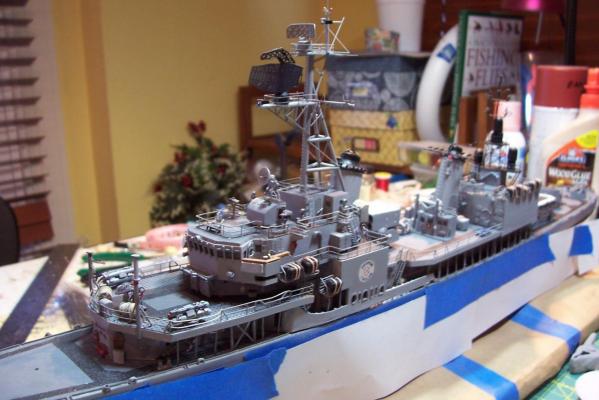
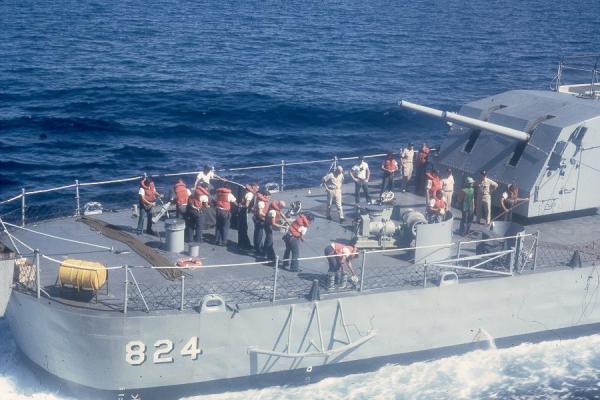
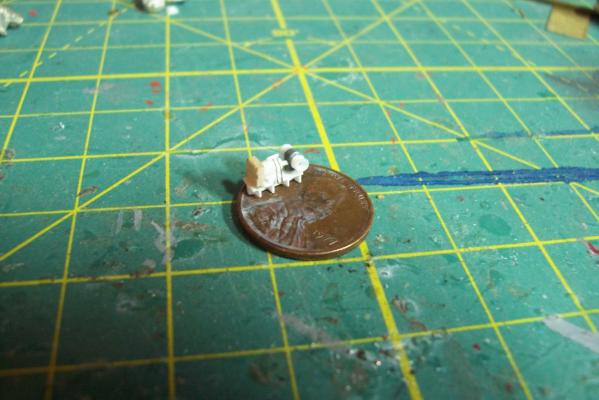
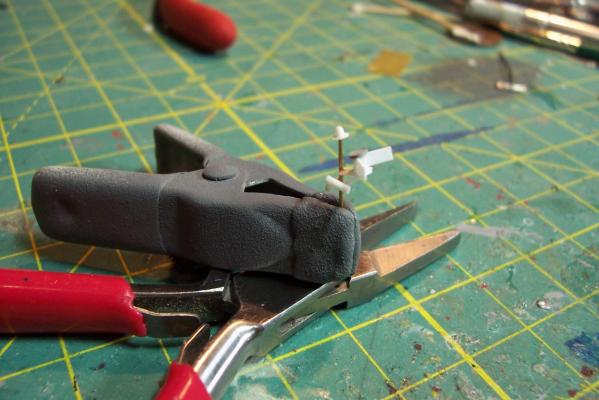
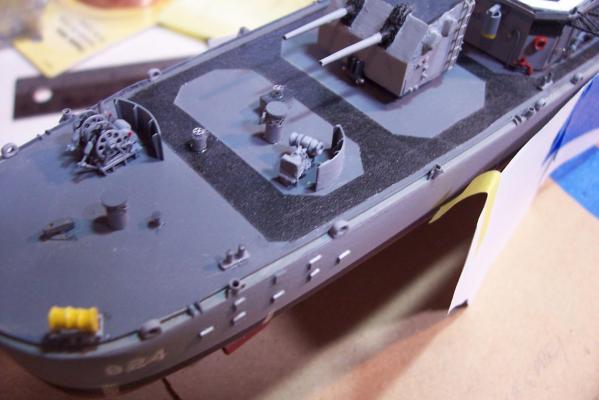
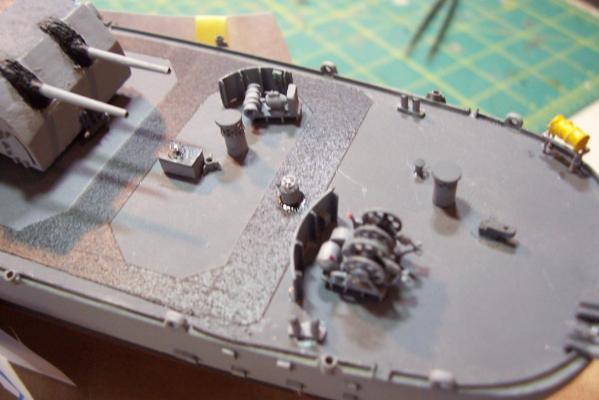
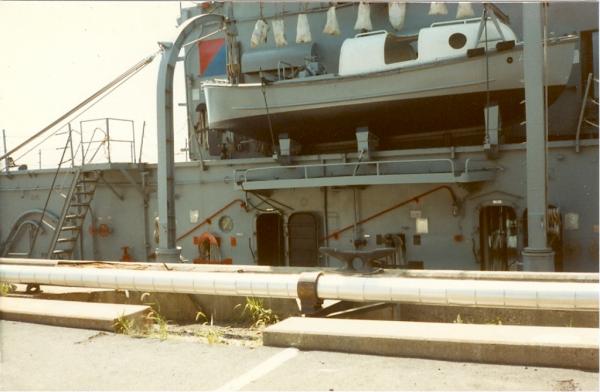
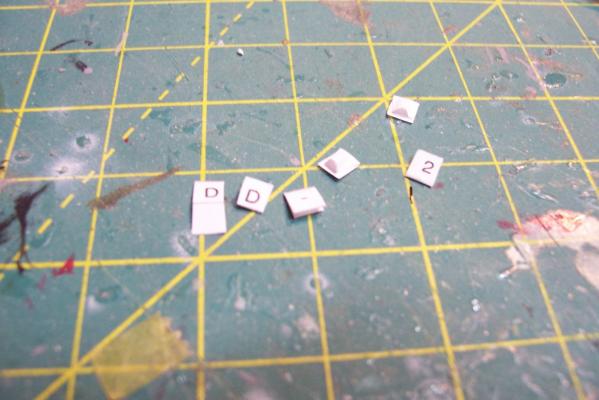
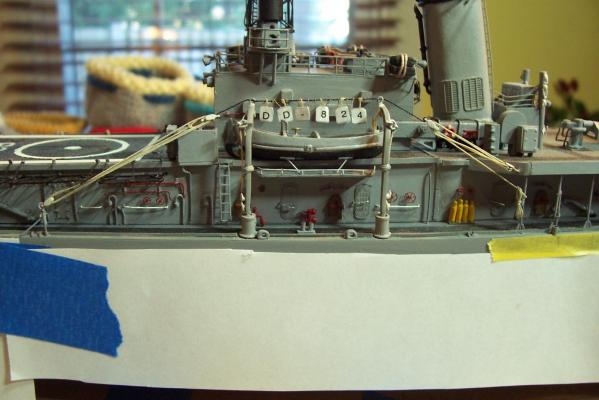
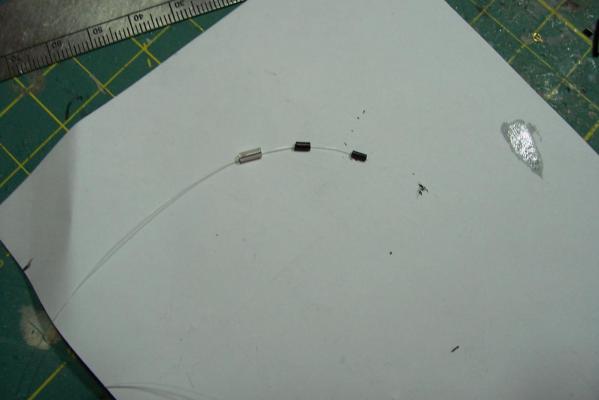
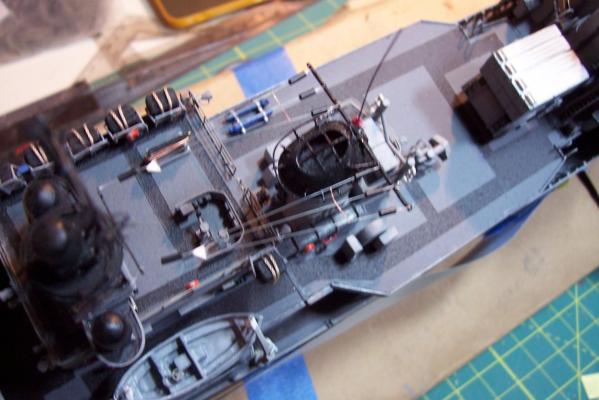
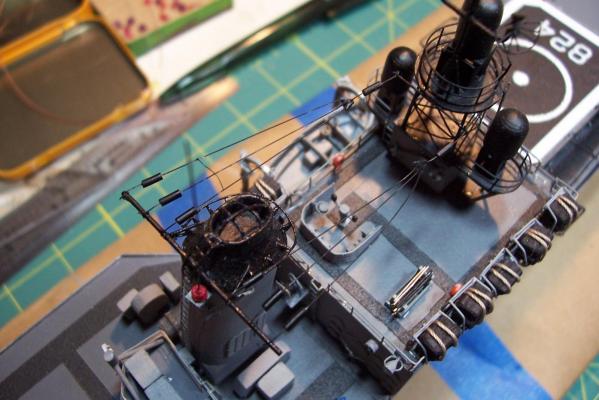
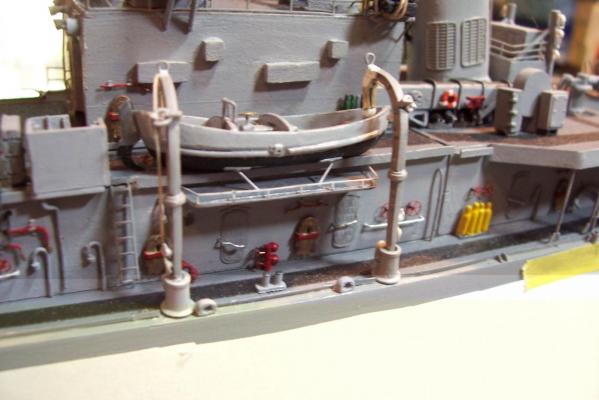
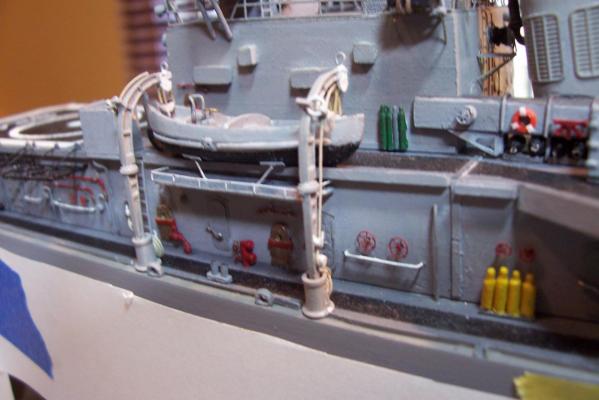
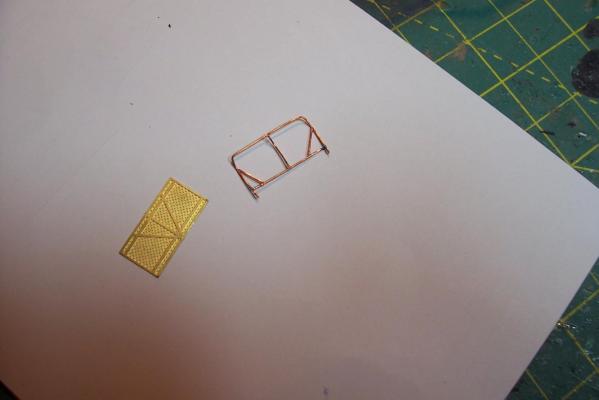
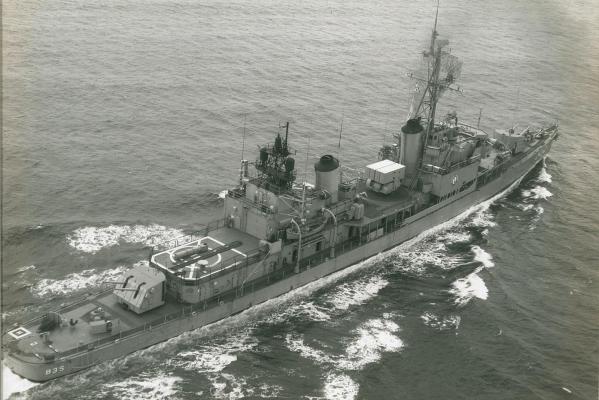
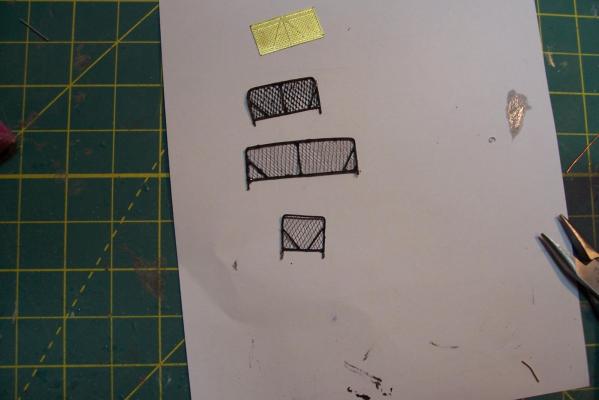
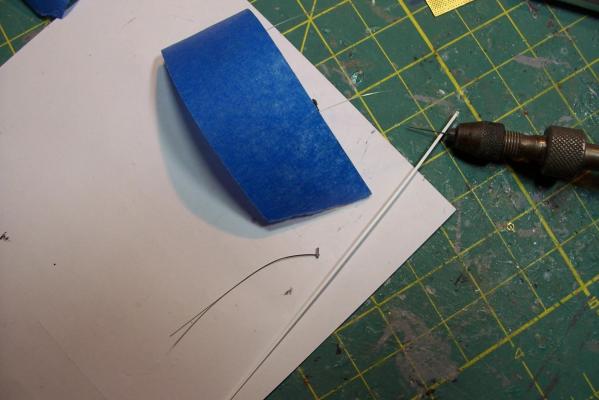
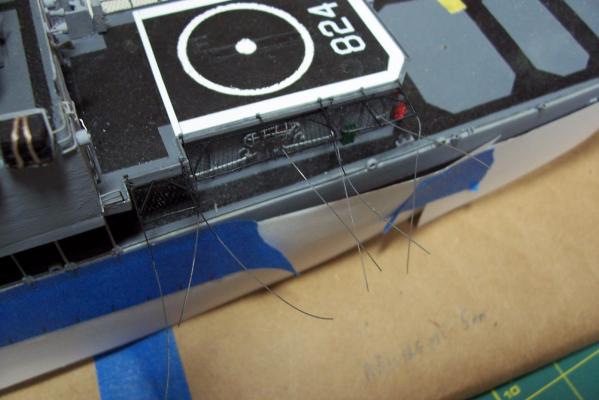
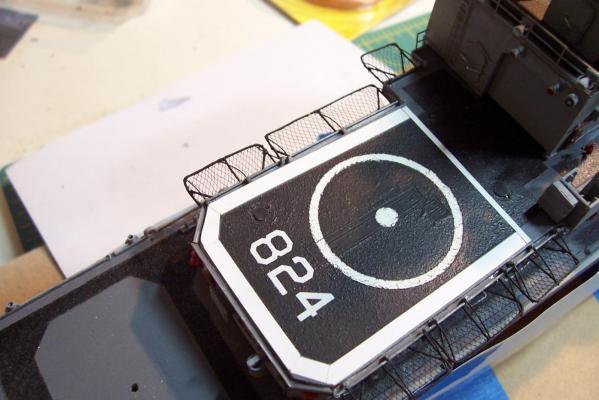
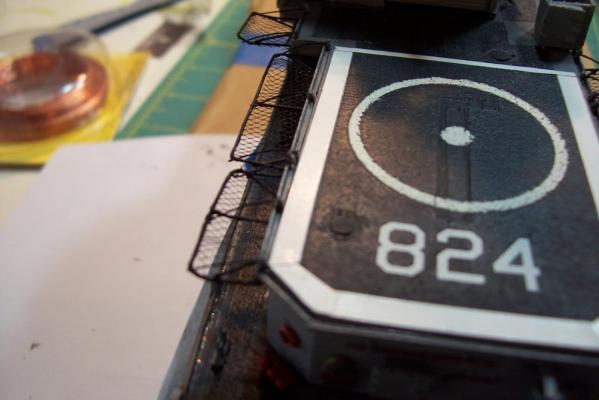
USS Basilone DD-824 by schooner - FINISHED - BlueJacket Shipcrafters - Scale 1:192 - from USS Gearing kit
in - Kit build logs for subjects built from 1901 - Present Day
Posted · Edited by schooner
Thanks Per, Scott and Yves.
Per - I'll probably spend a little time over on the dark side and build a couple of resin kits I have of USN ships I served on. It shouldn't take too long because I can't scratch details at 1/350 scale so it's simply a matter of "glue'n n' painting"